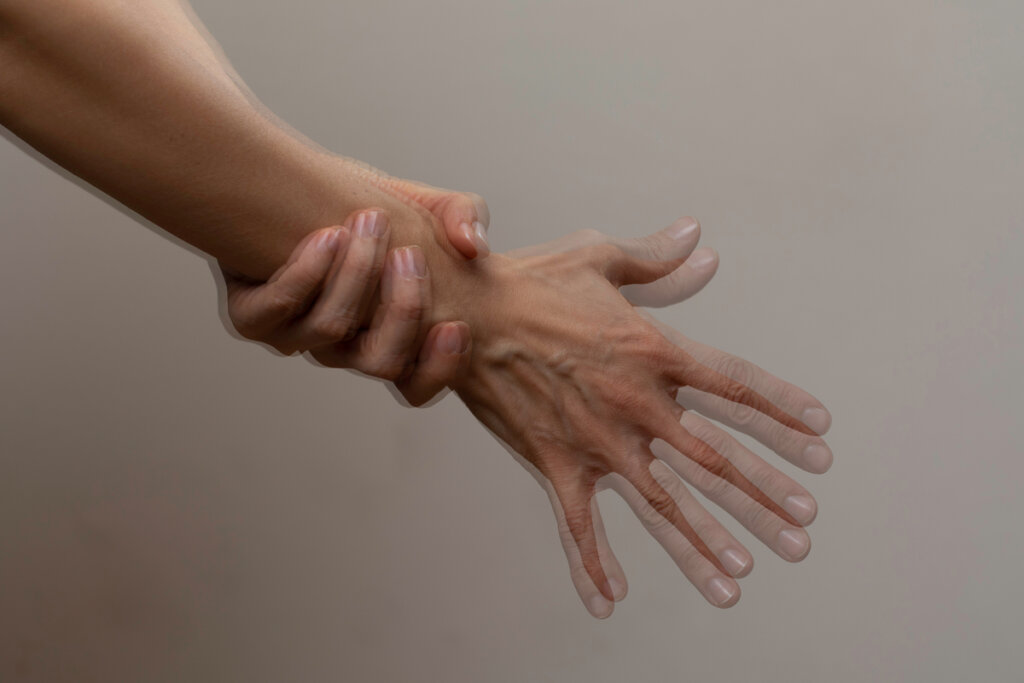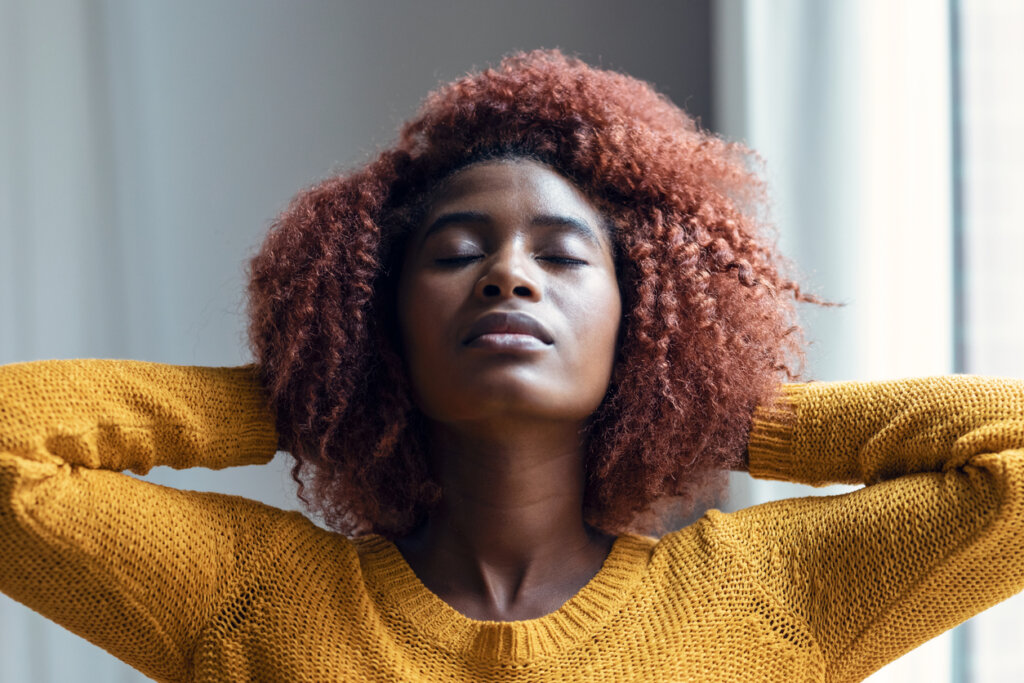Anxiety Tremors: What Causes Them and How to Control Them

Anxiety is a cognitive, physiological, behavioral, and emotional reaction related to the anticipation of a situation perceived as threatening. These responses are associated with fear and manifest as a future-oriented state of mind.
Anxiety is normal. However, when it’s triggered as a result of an overestimation of a future threat or a misappraisal of danger, it becomes pathological. Its main symptoms are agitation, tension, tiredness, dizziness, sweating, tremors, worry, hypervigilance, increased heart rate, and shortness of breath, among others.
In this article, we’ll focus on analyzing one of these symptoms: tremors. We’ll find out what causes them and how they can be controlled.

Anxiety tremors: what causes them?
An anxiety tremor is a rhythmic jerking movement that occurs in one or more parts of the body. It’s involuntary, so the individual has no control over it. Anxiety tremors aren’t dangerous but they are uncomfortable. Furthermore, they can sometimes trigger other anxiety-associated symptoms associated with worry.
The origin of anxiety tremors lies in the fight-or-flight response that the brain activates when an individual’s life is in danger. This stress response is an evolutionary reaction that we all have programmed into our neural networks. It’s through this that we can respond and protect ourselves from threats. It becomes problematic when the reaction is triggered without the presence of real danger.
The fight or flight response triggers the release of different hormones, such as adrenaline and cortisol. They end up generating various physical sensations such as increased heart rate, nausea, stomach pains, shortness of breath, and dilated pupils. These substances also cause tremors and chills.
Another factor that can influence the appearance of anxiety tremors is the accumulated muscular tension due to our imminent perception of danger. Our bodies need to discharge the tension and tremors are the perfect escape route for that purpose. In general, the parts of the body that tremble the most are those in which the muscular tension has been strongest.
How to control anxiety tremors
If you’re suffering from anxiety tremors, you’ll find they decrease if you manage to control your anxiety. Here are five strategies that can help you reduce it.
1. Take a nature walk
Going for a nature walk will help reduce your anxiety. Indeed, according to research, taking a nature walk has enormous benefits. It reduces anxiety, rumination, and negative affect and preserves positive affect. It also has cognitive benefits such as increased working memory performance.
If you have the opportunity to take nature walks, make sure you give everything around you your full attention, focusing on what’s happening at every moment. If you don’t have access to the countryside, you could put some plants in your house. In fact, indoor plants have been found to have a positive psychological effect on stress levels.
2. Practice mindfulness
Research claims that mindfulness is effective in treating anxiety symptoms and can also help control your reaction to stress. In addition, mindfulness can provide positive psychological effects, such as increased subjective well-being, reduced psychological symptoms and emotional reactivity, and better behavior regulation.
With mindfulness, your attention is brought to your experience of the here and now with openness, receptivity, and curiosity.
3. Carry out leisure activities
Leisure activities can help relieve your stress and anxiety by allowing you to redirect your attention to relaxing and enjoyable stimuli. Therefore, find an activity that clears your mind of all the worries and stress you have.
If you can do them with a friend, it’ll be even better. That’s because when you interact with people you love, you release oxytocin, a hormone associated with love and happiness.
4. Breathe with your diaphragm
Diaphragmatic breathing can help you lower your stress and anxiety levels. Research claims that diaphragmatic breathing can improve attention, affect, and stress levels. To breathe in this way, follow these instructions:
Get into a comfortable position, close your eyes and pay attention to your breathing. Note its rhythm and depth. Is it deep or shallow? Is it fast or slow? Then, place a hand on your abdomen and make sure that when you breathe you feel how your stomach inflates and deflates with each inhalation and exhalation. Place the other hand on your chest and try not to move it when you breathe. Only the hand on your abdomen should move.
Breathe in slowly through your nose, so that the hand on your abdomen feels the pressure of it rising. The hand on your chest should remain stationary. Hold your breath for a moment and exhale slowly through your mouth so that you feel the hand on your abdomen descend.

5. Take up yoga
Yoga combines physical movement, meditation, light exercise, and controlled breathing, all of which can provide you excellent stress relief (Francis & Beemer, 2019). A study found positive results in women who practiced Hatha yoga three times a week for four weeks. In fact, after 12 sessions, they experienced significant reductions in stress, depression, and anxiety.
Other research in adult men found that yoga stretches lower cortisol levels and have a positive effect on parasympathetic nerve activity. This promotes relaxation.
Finally, anxiety tremors are a symptom that, like others, can decrease when attending therapy. Indeed, seeking help if anxiety has ceased to be normal and has begun to significantly affect daily functioning is essential. You must never let anxiety control your life.
Anxiety is a cognitive, physiological, behavioral, and emotional reaction related to the anticipation of a situation perceived as threatening. These responses are associated with fear and manifest as a future-oriented state of mind.
Anxiety is normal. However, when it’s triggered as a result of an overestimation of a future threat or a misappraisal of danger, it becomes pathological. Its main symptoms are agitation, tension, tiredness, dizziness, sweating, tremors, worry, hypervigilance, increased heart rate, and shortness of breath, among others.
In this article, we’ll focus on analyzing one of these symptoms: tremors. We’ll find out what causes them and how they can be controlled.

Anxiety tremors: what causes them?
An anxiety tremor is a rhythmic jerking movement that occurs in one or more parts of the body. It’s involuntary, so the individual has no control over it. Anxiety tremors aren’t dangerous but they are uncomfortable. Furthermore, they can sometimes trigger other anxiety-associated symptoms associated with worry.
The origin of anxiety tremors lies in the fight-or-flight response that the brain activates when an individual’s life is in danger. This stress response is an evolutionary reaction that we all have programmed into our neural networks. It’s through this that we can respond and protect ourselves from threats. It becomes problematic when the reaction is triggered without the presence of real danger.
The fight or flight response triggers the release of different hormones, such as adrenaline and cortisol. They end up generating various physical sensations such as increased heart rate, nausea, stomach pains, shortness of breath, and dilated pupils. These substances also cause tremors and chills.
Another factor that can influence the appearance of anxiety tremors is the accumulated muscular tension due to our imminent perception of danger. Our bodies need to discharge the tension and tremors are the perfect escape route for that purpose. In general, the parts of the body that tremble the most are those in which the muscular tension has been strongest.
How to control anxiety tremors
If you’re suffering from anxiety tremors, you’ll find they decrease if you manage to control your anxiety. Here are five strategies that can help you reduce it.
1. Take a nature walk
Going for a nature walk will help reduce your anxiety. Indeed, according to research, taking a nature walk has enormous benefits. It reduces anxiety, rumination, and negative affect and preserves positive affect. It also has cognitive benefits such as increased working memory performance.
If you have the opportunity to take nature walks, make sure you give everything around you your full attention, focusing on what’s happening at every moment. If you don’t have access to the countryside, you could put some plants in your house. In fact, indoor plants have been found to have a positive psychological effect on stress levels.
2. Practice mindfulness
Research claims that mindfulness is effective in treating anxiety symptoms and can also help control your reaction to stress. In addition, mindfulness can provide positive psychological effects, such as increased subjective well-being, reduced psychological symptoms and emotional reactivity, and better behavior regulation.
With mindfulness, your attention is brought to your experience of the here and now with openness, receptivity, and curiosity.
3. Carry out leisure activities
Leisure activities can help relieve your stress and anxiety by allowing you to redirect your attention to relaxing and enjoyable stimuli. Therefore, find an activity that clears your mind of all the worries and stress you have.
If you can do them with a friend, it’ll be even better. That’s because when you interact with people you love, you release oxytocin, a hormone associated with love and happiness.
4. Breathe with your diaphragm
Diaphragmatic breathing can help you lower your stress and anxiety levels. Research claims that diaphragmatic breathing can improve attention, affect, and stress levels. To breathe in this way, follow these instructions:
Get into a comfortable position, close your eyes and pay attention to your breathing. Note its rhythm and depth. Is it deep or shallow? Is it fast or slow? Then, place a hand on your abdomen and make sure that when you breathe you feel how your stomach inflates and deflates with each inhalation and exhalation. Place the other hand on your chest and try not to move it when you breathe. Only the hand on your abdomen should move.
Breathe in slowly through your nose, so that the hand on your abdomen feels the pressure of it rising. The hand on your chest should remain stationary. Hold your breath for a moment and exhale slowly through your mouth so that you feel the hand on your abdomen descend.

5. Take up yoga
Yoga combines physical movement, meditation, light exercise, and controlled breathing, all of which can provide you excellent stress relief (Francis & Beemer, 2019). A study found positive results in women who practiced Hatha yoga three times a week for four weeks. In fact, after 12 sessions, they experienced significant reductions in stress, depression, and anxiety.
Other research in adult men found that yoga stretches lower cortisol levels and have a positive effect on parasympathetic nerve activity. This promotes relaxation.
Finally, anxiety tremors are a symptom that, like others, can decrease when attending therapy. Indeed, seeking help if anxiety has ceased to be normal and has begun to significantly affect daily functioning is essential. You must never let anxiety control your life.
All cited sources were thoroughly reviewed by our team to ensure their quality, reliability, currency, and validity. The bibliography of this article was considered reliable and of academic or scientific accuracy.
- Chand, S. P., & Marwaha, R. (2022). Anxiety. https://www.ncbi.nlm.nih.gov/books/NBK470361/
- Cleveland Clinic. (2019, 9 de diciembre). What happens to your body during the fight or flight response? https://health.clevelandclinic.org/what-happens-to-your-body-during-the-fight-or-flight-response/
- Bratman, G. N., Daily, G. C., Levy, B. J., & Gross, J. J. (2015). The benefits of nature experience: Improved affect and cognition. Landscape and Urban Planning, 138, 41-50.
- Deng, L., & Deng, Q. (2018). The basic roles of indoor plants in human health and comfort. Environmental Science and Pollution Research, 25(36), 36087-36101.
- Eda, N., Ito, H., & Akama, T. (2020). Beneficial effects of yoga stretching on salivary stress hormones and parasympathetic nerve activity. Journal of Sports Science & Medicine, 19(4), 695.
- Francis, A. L., & Beemer, R. C. (2019). How does yoga reduce stress? Embodied cognition and emotion highlight the influence of the musculoskeletal system. Complementary therapies in medicine, 43, 170-175.
- Keng, S. L., Smoski, M. J., & Robins, C. J. (2011). Effects of mindfulness on psychological health: A review of empirical studies. Clinical psychology review, 31(6), 1041-1056.
- Hoge, E. A., Bui, E., Marques, L., Metcalf, C. A., Morris, L. K., Robinaugh, D. J., … & Simon, N. M. (2013). Randomized controlled trial of mindfulness meditation for generalized anxiety disorder: effects on anxiety and stress reactivity. The Journal of clinical psychiatry, 74(8), 16662.
- Ma, X., Yue, Z. Q., Gong, Z. Q., Zhang, H., Duan, N. Y., Shi, Y. T., … & Li, Y. F. (2017). The effect of diaphragmatic breathing on attention, negative affect and stress in healthy adults. Frontiers in psychology, 874.
- Shohani, M., Badfar, G., Nasirkandy, M. P., Kaikhavani, S., Rahmati, S., Modmeli, Y., … & Azami, M. (2018). The effect of yoga on stress, anxiety, and depression in women. International journal of preventive medicine, 9.
- Watson, K. (2021, 31 de agosto). Anxiety Shaking: What Causes It? https://www.healthline.com/health/anxiety-shaking
This text is provided for informational purposes only and does not replace consultation with a professional. If in doubt, consult your specialist.







